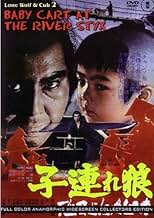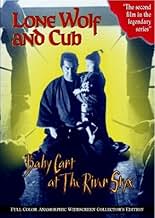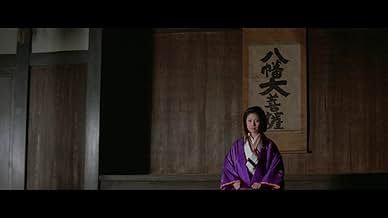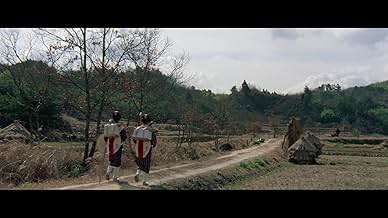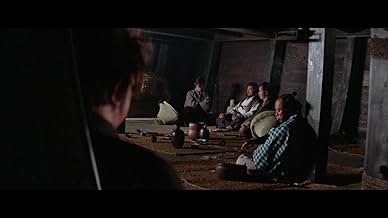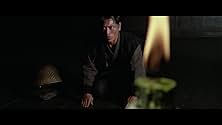Aggiungi una trama nella tua linguaTrailed by a clan of female ninja, Ogami is paid to assassinate a clan traitor accompanied by three killers known as the Gods of Death.Trailed by a clan of female ninja, Ogami is paid to assassinate a clan traitor accompanied by three killers known as the Gods of Death.Trailed by a clan of female ninja, Ogami is paid to assassinate a clan traitor accompanied by three killers known as the Gods of Death.
- Mitsugu
- (as Kanji Ebata)
Recensioni in evidenza
In this film, Itto continues his journey of vengeance with his young child along for the ride, rolling along in a cleverly weaponized wooden stroller. (Never before has a toddler been complicit in so many killings!) It's a fun movie for the mindless action, but it never really goes beyond that. At times the movie seems like it wants to be a more serious film, but then it veers back to a perpetually nonchalant Itto effortlessly slaying would-be killers along the road.
Overall, it felt like a movie attempting to bridge genres without ever cleanly landing in the one that fit.
When the wealthy Awa clan approach Itto, offering him 500 gold pieces to kill a man who might be able to ruin them financially, he accepts; in order to complete his mission, he must face many dangers, including a team of vicious female warriors, and the highly skilled Hidari brothers, also known as the Gods of Death.
Baby Cart at the River Styx sees director Kenji Misumi delivering a breathtaking sequel to his excellent Sword of Vengeance. Like a Japanese Sergio Leone, he once again uses extreme close-ups, rapid zooms, sparing use of a haunting soundtrack, and superbly choreographed violence to continue his epic tale of a man and boy on a gore-spattered journey through 'hell'.
From the opening scene in which Itto quickly dispatches of two Yagyu clansmen, through to the stunning climax which sees Lone Wolf and Cub battling the Hidaris in a desert, this film is a stunning and often beautiful display of carnage. Battles take place in complete silence, with the vanquished always taking a second or two before they fall to the ground, blood gushing from their wounds. Daigoro also gets in on the act, activating spring-loaded blades in his cart to slice off the feet of the enemy. Misumi's handling of these scenes is superb, with some great use of innovative and ground-breaking visual techniques (one great fight scene has images superimposed onto each other to give the action a surreal and dreamlike quality).
But it's not all mindless violence. There are occasional moments of tenderness too, with the close bond between father and son displayed in a couple of notable scenes: Ogami gently bathes Daigoro, with one hand on his sword in readiness for trouble; and Daigoro nurses his injured father back to health, trading his jacket for food.
My only gripe with Baby Cart at the River Styx is that the film is often very dark, and it was extremely hard to see what was going on, particularly during the many night scenes. Whilst this may be due to my DVD being a bad transfer, it did affect my enjoyment of the film (I had to re-watch the gory dismemberment of one unfortunate shinobi at the hands of the female ninjas with my TV's brightness and contrast whacked right up), which is why I give it slightly less than Sword of Vengeance7.5/10 (although I have to round my rating up to 8 for IMDb, which technically puts it on a par with the first one).
The entire "Kozure Ôkami" cycle ranks high among my personal all-time favorites, and "Baby Cart At The River Styx" is my personal favorite of them all, for a variety of reasons. The enemies Ogami Itto has to compete with are one of these reasons. The Lone Wolf and his son have to stand up against a group of female ninjas lead by Yagyu Sayaka (Kayo Matsuo) as well as three assassin brothers called the 'Masters of Death'. The fighting sequences and stylish bloodshed are among the most awesome ever brought to screen, the film is absolutely stunning from the very beginning, the atmosphere is incomparable, and the score is ingenious as in the first film. Ogami Itto's son Daigoro (Akihiro Tomikawa) has grown a bit, and learned to talk (but hardly ever does), since the first film. Daigoro is, as far as I am concerned arguably the greatest child-character ever in a film. The father-son relationship of Ogami Itto and Daigoro is one of the great aspects of the 'Ôkami' films, and makes these ultra-violent Chambara-highlights heart-warming at times. Daigoro's role has become more active in this second entry to the series, and he even actively engages in some of the crafty tricks in his father's fights. Tomisaburo Wakayama is again brilliant in the lead and the rest of the performances are also great, especially Kayo Matsuo is excellent as ninja-lady Sayaka, and so are the three 'Masters Of Death'.
"Lone Wolf And Cub: Baby Cart at the River Styx" is pure perfection in every aspect. The performances and characters, the incomparable atmosphere and locations, the brilliant score and photography, the stunning swordplay,... there is not one single aspect about this film that is not brilliant. I have seen too many films to come up with a list of all-time favorites, but if I ever was to make such a list, this second entry to the brilliant 'Okami' series would definitely be in the top 10! An incomparably brilliant masterpiece of blood-soaked swordplay-cinema, "Kozure Ôkami: Sanzu no kawa no ubaguruma" is essential for every true lover of film! 10/10!
There were a couple of funny moments relating to the little boy and his participation in the various battles. The use of the boy for some humor was a plus.
The fighting scenes were mostly good, but not as good as the Zatoichi movies which I love and have seen them all. The bloody effects were pretty bad in some scenes, as the injured (killed) samurai sometimes started bleeding many seconds after they were stabbed or sliced. In one scene, Lone Wolf impales two guys at the same time. One of them immediately starts spraying lots of blood from his wound. The other guy gets a trickle of blood dripping out. It would have been more impressive if the double-impalement lead to double sprays of blood.
Several heads were sliced open, and the last one looked like a venus flytrap popping open, and there were no brains, eyes, or other material visible, it looked totally silly. Then a single spray of blood shot straight up into the air from the middle of the head. Laughable and really bad special effects.
Otherwise, the film was pretty good. It had a lot of action, some good story lines, and some humor.
Lo sapevi?
- QuizThe distinctive hats worn by the Gods of Death, are a traditional Japanese straw hat often associated with ronin. The style of hat is known as roningasa. 'Ronin' meaning masterless and wandering samurai, and 'gasa' meaning hat.
- BlooperWhen Ogami and Daigoro are walking through the forest shortly before being attacked by Kurokawa and his ninja henchmen (around the 31:30 mark), cars can be seen driving by in the background on the left side of the frame.
- Citazioni
Benma Hidari: [Ogami Itto has bested him and slashed him across the neck with a sword; blood is starting to flow from the wound, making a certain sound] My neck... my own neck... It sounds like it's wailing. My neck was sliced open diagonally. The cut wails like a cold winter wind. They call it "mogari-bue," - the whistle of a fallen tiger. I've always wished to kill someone, just once, and create such a fine cut and to sing this tune. Now I'm hearing it from my own neck. What a laugh.
[rolls over dead, with blood spurting out from his neck wound onto the sand]
- ConnessioniEdited into Shogun il giustiziere (1980)
I più visti
- How long is Lone Wolf and Cub: Baby Cart at the River Styx?Powered by Alexa
Dettagli
- Data di uscita
- Paese di origine
- Lingua
- Celebre anche come
- Lone Wolf and Cub: Baby Cart at the River Styx
- Aziende produttrici
- Vedi altri crediti dell’azienda su IMDbPro
Contribuisci a questa pagina


